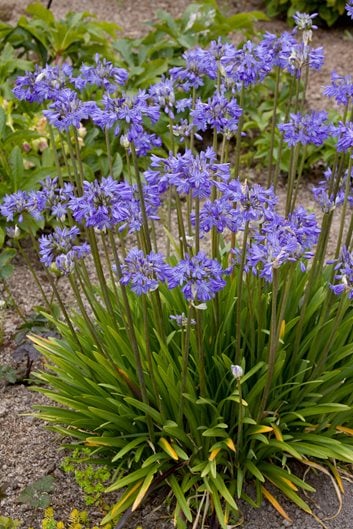Releasing the Secret to Effective Agapanthus Cultivation: Advice for a Flourishing Garden
In the world of gardening, growing agapanthus successfully needs a critical strategy that incorporates numerous facets of plant treatment. By comprehending the subtleties of agapanthus growing, one can create an atmosphere where these plants thrive and bloom perfectly.
Growing Agapanthus: Finest Practices
When growing Agapanthus, correct soil preparation is important for guaranteeing successful development and growth of these lovely flowers. Agapanthus, generally referred to as Lily of the Nile or African lily, thrives in well-draining dirt with a somewhat acidic to neutral pH level - Agapanthus. Before planting, it is important to change hefty clay soils with natural issue such as compost or peat moss to boost drainage and offer essential nutrients for the plants
To grow Agapanthus, pick a location that receives full sunshine to partial color, as this will advertise healthy development and plentiful blooming. Dig an opening twice the diameter of the plant's root round and put the Agapanthus at the same depth it was previously growing. Delicately backfill the hole with dirt, weighing down firmly to remove any kind of air pockets around the origins.
Water the recently grown Agapanthus thoroughly and remain to maintain the soil uniformly damp, especially throughout the plant's energetic expanding period. Agapanthus. Applying a well balanced fertilizer once a month can additionally support the plant's development and blooming. By following these best practices for growing Agapanthus, you can create a stunning display of these captivating flowers in your garden
Perfect Dirt Issues for Agapanthus
For optimum development and flowering success of Agapanthus plants, making certain the soil problems are suitable is important. Agapanthus favors dirt that is abundant in nutrients, so integrating a balanced fertilizer throughout the growing period can advertise healthy development and dynamic flowers.

Watering and Feeding Tips
To make certain healthy development and vivid blossoms, correct watering and feeding methods are important for successful Agapanthus cultivation. Agapanthus plants gain from regular watering, especially during the growing period. It is suggested to water deeply as soon as a week, making certain the soil is moist however not soaked. Throughout warm weather condition or in pots, even more regular watering might be required to stop the dirt from drying entirely.
When it pertains to fertilizing Agapanthus, a well balanced plant food with equivalent parts nitrogen, phosphorus, and potassium can be applied in the spring to advertise healthy development and flowering. Slow-release fertilizers are optimal for supplying nutrients progressively over an extended duration. Avoid over-fertilizing, as this can lead to excessive vegetation growth at the cost of blossoms.
Furthermore, integrating organic issue like garden compost into the dirt can improve nutrient levels and improve dirt structure, helping in the total health and wellness of the Agapanthus plants. By following these watering and feeding pointers, garden enthusiasts can guarantee their Agapanthus plants thrive and create stunning display screens of flowers.
Trimming and Deadheading Techniques
Correct pruning and deadheading methods play an essential duty in maintaining the wellness and looks of Agapanthus plants, complementing the crucial my company methods of Homepage watering and feeding for effective cultivation. Trimming Agapanthus includes removing invested blossom heads, dead or yellowing fallen leaves, and overall shaping of the plant to promote much better development. Deadheading, the process of eliminating discolored flowers, not just boosts the plant's appearance however additionally urges further growing.
When deadheading Agapanthus, it is recommended to trim off the blossom stem at the base using sharp, clean shears. This process redirects the plant's power from seed production back into origin and vegetation development, advertising a healthier and much more robust plant. Routine deadheading can extend the blooming duration of Agapanthus and prevent self-seeding, which can result in congestion.
In terms of pruning, Agapanthus typically gain from a light trim after blooming to clean up the plant and encourage fresh growth. Cutting down the spent flower stems and eliminating any type of broken or dead vegetation helps maintain the plant's vigor and overall look. Nonetheless, it is important to avoid cutting into the crown of the plant, as this can damage its wellness.

Protecting Agapanthus From Pests and Diseases
Carrying out effective parasite and disease monitoring techniques is critical to safeguarding the visit the site health and vitality of Agapanthus plants in farming. One common bug that influences Agapanthus is the Agapanthus borer, a caterpillar that passages into the plant, creating damage to the leaves and flowers.
In enhancement to parasites, Agapanthus are at risk to conditions such as origin rot and fungal fallen leave areas. By staying alert and dealing with insect and disease issues promptly, gardeners can aid their Agapanthus grow and prosper.

Final Thought
In conclusion, successful farming of agapanthus requires appropriate growing methods, excellent soil problems, adequate watering and fertilizing, normal trimming and deadheading, and defense from insects and illness. By adhering to these tips and techniques, gardeners can make sure a prospering yard full of lovely agapanthus blossoms. Agapanthus. Remember to maintain regular treatment and attention to information to promote the health and durability of these sensational plants
When growing Agapanthus, appropriate dirt prep work is crucial for guaranteeing successful growth and advancement of these lovely blossoms.Water the newly grown Agapanthus thoroughly and continue to keep the soil uniformly damp, especially during the plant's active growing season.For ideal growth and flowering success of Agapanthus plants, making sure the dirt problems are ideal is important. When planting or transplanting Agapanthus, guarantee the dirt is well-prepared to offer the needed structure for the plants to develop themselves effectively. One typical insect that impacts Agapanthus is the Agapanthus borer, a caterpillar that passages right into the plant, creating damages to the leaves and blossoms.
 Edward Furlong Then & Now!
Edward Furlong Then & Now! Jennifer Grey Then & Now!
Jennifer Grey Then & Now! Ariana Richards Then & Now!
Ariana Richards Then & Now! Burke Ramsey Then & Now!
Burke Ramsey Then & Now! Tina Majorino Then & Now!
Tina Majorino Then & Now!